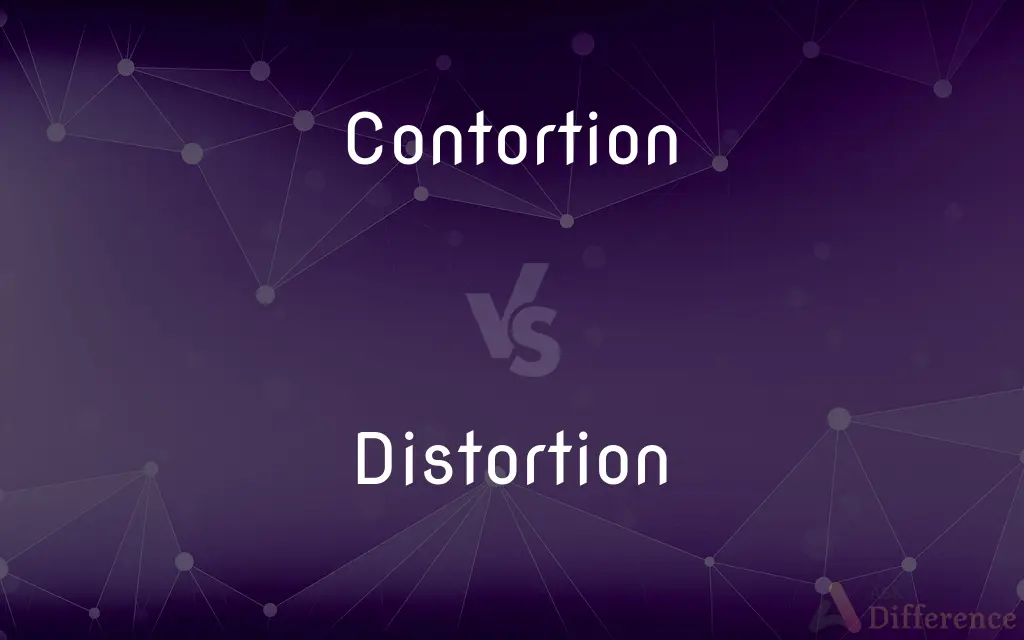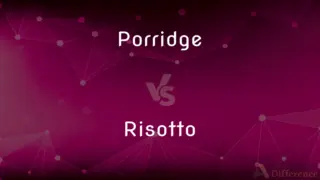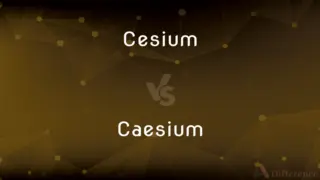Contortion vs. Distortion — What's the Difference?
By Fiza Rafique & Urooj Arif — Updated on April 14, 2024
Contortion primarily refers to the act of twisting or bending a body into unusual positions, while distortion encompasses the alteration or misrepresentation of something, often information or an image.

Difference Between Contortion and Distortion
Table of Contents
ADVERTISEMENT
Key Differences
Contortion is an artistic or physical discipline involving the twisting and bending of the human body into intricate and often extreme positions. While contortion focuses on flexibility and bodily control, distortion generally refers to the act of altering the original shape or essence of an object or information. This can involve visual alterations, as in photography or graphics, or the manipulation of facts and data.
Contortionists often perform in circuses, dance, and performance art, showcasing their ability to achieve seemingly impossible poses. On the other hand, distortion is widely used in various fields such as art, photography, and communication to create a specific effect or convey a certain message, often by altering reality or perception.
The practice of contortion emphasizes physical skill and endurance, where performers train for years to gain extraordinary flexibility and strength. In contrast, distortion can be instantly applied to a photograph or a story to transform its appearance or interpretation without any physical effort.
While contortion is admired and seen as a form of entertainment and art, distortion, especially of facts, can have negative connotations, suggesting deceit or misrepresentation. However, in artistic contexts, such as surreal photography, distortion is used positively to evoke emotions or provoke thought.
Contortion and distortion both involve transformation, the former physical and the latter often abstract or representational, impacting bodies or information, respectively.
ADVERTISEMENT
Comparison Chart
Definition
Twisting/bending the body in unusual positions.
Altering the appearance or nature of something.
Primary Use
Artistic performances and physical showcases.
Art, photography, and information manipulation.
Skills Required
Physical flexibility, strength, and endurance.
Technical skills in media manipulation or persuasive communication.
Perception
Generally viewed as a talent or art.
Can be seen as creative or deceptive, depending on context.
Output
Live performances or recorded shows.
Altered images, texts, or sounds.
Compare with Definitions
Contortion
A performance art involving extreme physical bending and flexing.
The contortionist amazed the audience with her backbend.
Distortion
The act of misrepresenting or twisting information.
The article was criticized for its distortion of the facts.
Contortion
The act of twisting the body into unusual positions.
Yoga sometimes includes contortion-like poses that improve flexibility.
Distortion
The effect of altering reality in various contexts.
Her statement was a distortion of what actually happened.
Contortion
Physical manipulation of body parts into extraordinary forms.
Contortion requires both innate ability and rigorous training.
Distortion
Alteration of an image or sound in media.
He used lens distortion to achieve the photograph’s unique effect.
Contortion
A display of hyperflexibility and body control.
Contortion is often featured in circus acts and modern dance.
Distortion
A change that warps the original form or concept.
The mirror’s curve caused a visual distortion of her reflection.
Contortion
Art form focusing on extreme physical movements.
Her contortion routine incorporated elements of ballet.
Distortion
Manipulative editing in communication or art.
Distortion pedals are popular among electric guitarists for their sound-altering capabilities.
Contortion
Contortion (sometimes contortionism) is a performance art in which performers called contortionists showcase their skills of extreme physical flexibility. Contortion acts often accompany acrobatics, circus acts, street performers and other live performing arts.
Distortion
Distortion is the alteration of the original shape (or other characteristic) of something. In communications and electronics it means the alteration of the waveform of an information-bearing signal, such as an audio signal representing sound or a video signal representing images, in an electronic device or communication channel.
Contortion
To twist, wrench, or bend out of proper or natural shape
Fingers contorted by arthritis.
Distortion
The act or an instance of distorting.
Contortion
To cause to deviate from what is normal, proper, or accurate
The leaders of the movement contorted their own principles in trying to get what they wanted.
Distortion
The condition of being distorted.
Contortion
To become contorted
"Her face contorts with pain and horror, as if something deep inside her has been shattered" (Rachel Simon).
Distortion
A statement that twists fact; a misrepresentation.
Contortion
The act of contorting, twisting or deforming something, especially oneself.
Distortion
The alteration of the original form of a signal representing an image, a sound, a waveform, or other information.
Contortion
A form of acrobatic display which involves the dramatic bending and flexing of the human body.
Distortion
A visible or audible effect of such an alteration, such as the warping of an image or noise in an audio recording.
Contortion
A twisting; a writhing; wry motion; a twist; as, the contortion of the muscles of the face.
All the contortions of the sibyl, without the inspiration.
Distortion
(Psychology) The modification of unconscious impulses into forms acceptable by conscious or dreaming perception.
Contortion
The act of twisting or deforming the shape of something (e.g., yourself)
Distortion
An act of distorting.
Contortion
A tortuous and twisted shape or position;
They built a tree house in the tortuosities of its boughs
The acrobat performed incredible contortions
Distortion
A result of distorting.
Distortion
A misrepresentation of the truth.
The story he told was a bit of a distortion.
Distortion
Noise or other artifacts caused in the electronic reproduction of sound or music.
This recording sounds awful due to the distortion.
Distortion
An effect used in music, most commonly on guitars in rock or metal.
Distortion
(optics) an aberration that causes magnification to change over the field of view.
Distortion
The act of distorting, or twisting out of natural or regular shape; a twisting or writhing motion; as, the distortions of the face or body.
Distortion
A wresting from the true meaning.
Distortion
The state of being distorted, or twisted out of shape or out of true position; crookedness; perversion.
Distortion
An unnatural deviation of shape or position of any part of the body producing visible deformity.
Distortion
A change for the worse
Distortion
A shape resulting from distortion
Distortion
An optical phenomenon resulting from the failure of a lens or mirror to produce a good image
Distortion
A change (usually undesired) in the waveform of an acoustic or analog electrical signal; the difference between two measurements of a signal (as between the input and output signal);
Heavy metal guitar players use vacuum tube amplifiers to produce extreme distortion
Distortion
The act of distorting something so it seems to mean something it was not intended to mean
Distortion
The mistake of misrepresenting the facts
Common Curiosities
Are there different types of distortion?
Yes, distortion can occur visually, auditorily, or contextually in the communication of information.
What is contortion?
Contortion is the art of twisting and bending the body into unusual and extreme positions, showcasing flexibility and control.
What is distortion?
Distortion refers to the alteration or misrepresentation of the original shape or essence of something, such as an image or information.
What physical attributes are necessary for contortion?
A contortionist needs exceptional flexibility, muscle control, and pain tolerance.
Can distortion be intentional?
Yes, distortion can be intentionally used in art, photography, and information to achieve a specific effect or message.
How is contortion displayed in performances?
Contortion performances can be seen in circuses, stage shows, and street performances.
How do contortionists train?
Contortionists typically undergo years of physical training focusing on flexibility, strength, and endurance.
Is contortion considered a form of dance?
Contortion is often incorporated into dance and performance art but is distinct due to its focus on extreme flexibility.
How is distortion used in photography?
Photographers use lens distortion, editing tools, and perspective changes to creatively alter images.
Can everyone learn to be a contortionist?
While basic flexibility can be improved, the extreme levels required for professional contortion often require starting at a young age.
What are common venues for contortion performances?
Contortion is commonly performed in circuses, dance theaters, and special events like cultural festivals.
Can distortion have negative effects?
When used to mislead or deceive, particularly in information dissemination, distortion can have harmful consequences.
How does distortion affect communication?
Distortion in communication can lead to misunderstandings and misinformation, affecting public perception.
What skills are needed to create distortion in media?
Skills in digital editing, artistic design, and creative thinking are needed to effectively create distortions in media.
Is distortion always bad?
Not necessarily; in arts and creative fields, distortion is used to explore new aesthetics and perspectives.
Share Your Discovery

Previous Comparison
Porridge vs. Risotto
Next Comparison
Cesium vs. CaesiumAuthor Spotlight
Written by
Fiza RafiqueFiza Rafique is a skilled content writer at AskDifference.com, where she meticulously refines and enhances written pieces. Drawing from her vast editorial expertise, Fiza ensures clarity, accuracy, and precision in every article. Passionate about language, she continually seeks to elevate the quality of content for readers worldwide.
Co-written by
Urooj ArifUrooj is a skilled content writer at Ask Difference, known for her exceptional ability to simplify complex topics into engaging and informative content. With a passion for research and a flair for clear, concise writing, she consistently delivers articles that resonate with our diverse audience.
















































